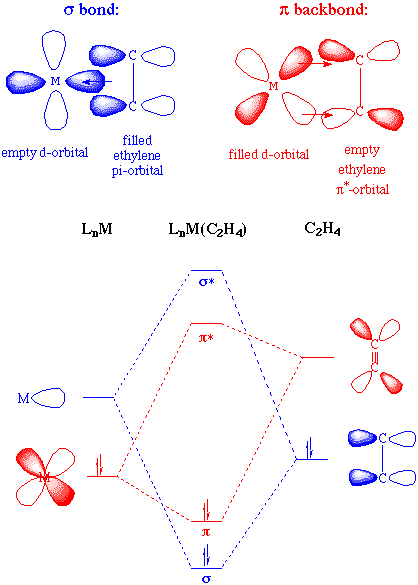
Alkene or olefin ligands are common in organotransition metal chemistry. In fact, the first organotransition metal complex, Zeise's salt (K[PtCl3(C2H4]·H2O) was an alkene complex although its true nature was not unambiguously determined until about 100 years after its discovery.
The bonding in alkene complexes is described by the Dewar-Chatt-Duncanson model, which provides us with a bonding picture not unlike that seen in carbonyl or phosphine complexes. A sigma-type donation from the C=C pi orbital with concomitant pi-backbonding into an empty pi* orbital on the ethylene presents us with a synergistic bonding situation: the greater the sigma donation to the metal, the greater the pi-backbonding:

The greater the electron density back-donated into the pi* orbital on the alkene, the greater the reduction in the C=C bond order. An alternative way of stating this would be to say that the hybridization of the alkene carbon changes from sp2 to sp3 as back-donation increases. Either formalism describes two limiting structures: a planar olefin adduct and a metallocyclopropane. X-ray crystallographic studies confirm that the as the C-C bond length increases, the CH2 plane is distorted from the ideal planar geometry of an alkene:

The structural distortion of a bound alkene can also be detected by NMR: the JCH of alkene-like sp2 carbons is typically around 160 Hz whereas sp3-like carbons have a JCH around 120 Hz. Unlike carbonyl stretching frequencies, the C=C IR band (around 1500 cm-1) is usually weak and not well-correlated to C-C bond length.
Electronic factors play a large role in the binding of alkenes to transition metals. For example, tetrafluoroethylene will bind more tightly than ethylene to a low valent metal complex because the presence of electron-withdrawing groups on the olefin results in poorer sigma donation and lowers the energy of the pi* orbital (providing better overlap for backbonding). Likewise, ethylene (like carbon monoxide) is a poor ligand for d0 metal complexes because there are no d-electrons to engage in back-bonding.
The stability of alkene complexes also depends on steric factors as well. An empirical ordering of relative stability would be:
tetrasubstituted < trisubstituted < trans-disubstituted < cis-disubstituted < monosubstituted < ethylene.
Alkene complexes can be synthesized by several methods:
The bonding of an alkene to a transition metal can activate the ligand to electrophilic or nucleophilic attack depending on the nature and charge of the metal center. For example, if there is a high formal charge on the metal center then the olefin is subject to attack by nucleophiles at the face opposite the metal (giving trans addition). Likewise, electron rich metal centers in low oxidation states are activated for attack by electrophiles at the C-C bond.
The reaction chemistry of these complexes is quite broad and could form another textbook in itself. For some other examples of alkene reactivity look at the sections on olefin metathesis, olefin polymerization and insertion reactions.